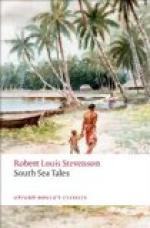So in Samoa only the spirits of the unburied awake fear. During the late war many fell in the bush; their bodies, sometimes headless, were brought back by native pastors and interred; but this (I know not why) was insufficient, and the spirit still lingered on the theatre of death. When peace returned a singular scene was enacted in many places, and chiefly round the high gorges of Lotoanuu, where the struggle was long centred and the loss had been severe. Kinswomen of the dead came carrying a mat or sheet and guided by survivors of the fight. The place of death was earnestly sought out; the sheet was spread upon the ground; and the women, moved with pious anxiety, sat about and watched it. If any living thing alighted it was twice brushed away; upon the third coming it was known to be the spirit of the dead, was folded in, carried home and buried beside the body; and the aitu rested. The rite was practised beyond doubt in simple piety; the repose of the soul was its object: its motive, reverent affection. The present king disowns indeed all knowledge of a dangerous aitu; he declares the souls of the unburied were only wanderers in limbo, lacking an entrance to the proper country of the dead, unhappy, nowise hurtful. And this severely classic opinion doubtless represents the views of the enlightened. But the flight of my Lafaele marks the grosser terrors of the ignorant.
This belief in the exorcising efficacy of funeral rites perhaps explains a fact, otherwise amazing, that no Polynesian seems at all to share our European horror of human bones and mummies. Of the first they made their cherished ornaments; they preserved them in houses or in mortuary caves; and the watchers of royal sepulchres dwelt with their children among the bones of generations. The mummy, even in the making, was as little feared. In the Marquesas, on the extreme coast, it was made by the household with continual unction and exposure to the sun; in the Carolines, upon the farthest west, it is still cured in the smoke of the family hearth. Head-hunting, besides, still lives around my doorstep in Samoa. And not ten years ago, in the Gilberts, the widow must disinter, cleanse, polish, and thenceforth carry about her, by day and night, the head of her dead husband. In all these cases we may suppose the process, whether of cleansing or drying, to have fully exorcised the aitu.




